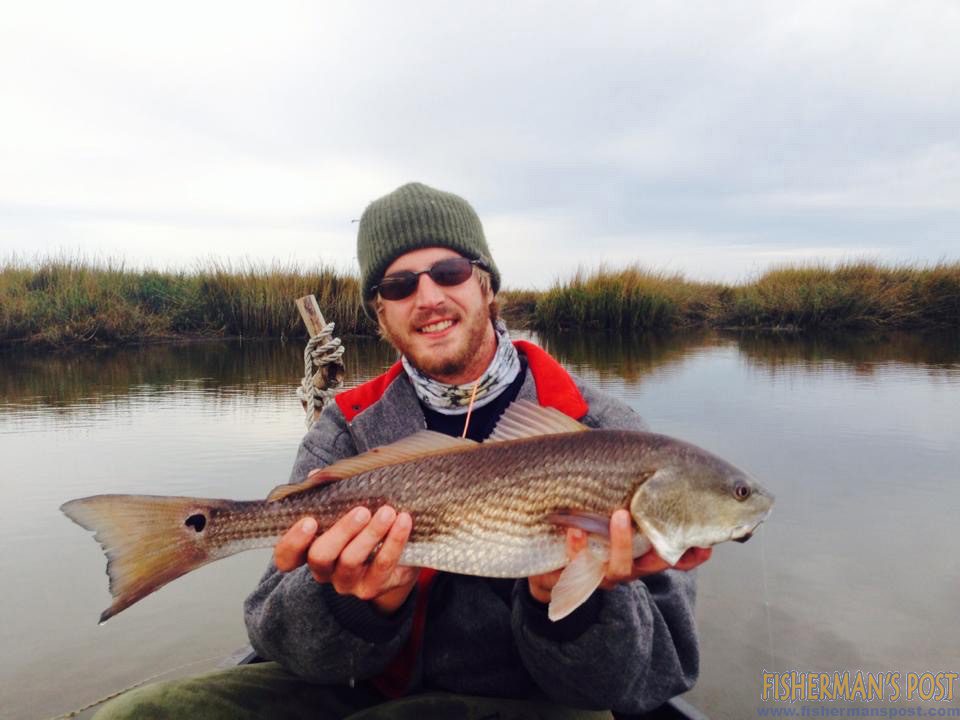Southport – March 5, 2015
Jimmy, of Wildlife Bait and Tackle, reports that fishing opportunities have been limited over the course of the winter, but anglers were still finding some decent inshore action until the brutal cold spells of the past few weeks.

Brent Hinson, of Wilmington, with a 25″ red drum he caught and released inshore of Pleasure Island while casting a Z-Man Paddlerz from his canoe.
Most of the winter action has been taking place in the creeks and canals off the ICW and Cape Fear River, where speckled trout and red and black drum have taken up residence in their cold-water haunts far up the smaller tributaries. Anglers have been hooking the specks and a few reds while slowly working lightly-weighted soft plastics around docks, deeper holes, mud flats, and oyster rocks in those areas. More reds and the black drum will take an interest in shrimp and other baits on bottom rigs.
The bite had slowed down a bit as of the past weekend. The fish haven’t gone anywhere and no large-scale cold kills have been reported, so they’re still around and should be getting more active by the day as warmer weather and rising water temperatures mark the coming of spring.
As the water warms further, the fish will move out of the creeks into the ICW and marshes and become even more active.
The beginning of spring also typically brings a solid run of sea mullet to the lower Cape Fear River, though it may be a bit late this year due to all the cold. The fish feed on mudflats and deeper holes near the mouth of the river, and once they arrive, anglers should be able to find fast action and plenty of the tasty panfish to fill their coolers. Shrimp, bloodworms, and Fish Bites baits on double-drop bottom rigs are all that’s needed to fool the mullet.
Out in the ocean, anglers should be able to find gray trout and black sea bass feeding at nearshore structure as the water warms, and they can fool both with baited bottom rigs or jigging lures like Stingsilvers.
Bottom structure further offshore from Frying Pan Tower to the break will play host to more and larger sea bass along with other tasty targets like beeliners and triggerfish.
Wally, of Oak Island Fishing Charters, reports that anglers making it out in the ocean over the month of March have several options depending on how far they want to travel.
Black sea bass should be looking for meals at bottom structure well inshore of the break, and anglers can tempt the bass to bite squid, cut baits, and just about anything else they can pin to the hook of a bottom rig.
A bit further out, anglers can expect to see king mackerel wherever they can find water in the upper-60’s, with Frying Pan Tower a hotspot unless it’s too cool. Trolling cigar minnows, spoons, and strip baits around bait concentrations and along temperature edges in the area is the way to put the kings in the boat.
Those making it all the way to local Gulf Stream hotspots like the Steeples and Blackjack Hole stand solid chances at wahoo and blackfin tuna action. Both rigged ballyhoo and artificial trolling lures will fool the blue water predators.
Ryan, of Fugitive Charters, reports that anglers should be able to find some legal black sea bass and plenty of gray trout at nearshore structure within a few miles of the beaches over the month of March. Both will pounce on small jigging spoons or bottom rigs with a wide variety of natural baits.
King mackerel are feeding around their offshore wintering grounds, and anglers should be able to find them concentrated around the 40 mile range wherever they can find water temperatures in the upper-60’s. The kings will happily attack spoons, skirted strip baits, and cigar minnows that anglers troll around the schools of fish.
Wahoo action is generally good in the cooler months out in the Gulf Stream, but anglers usually need to seek out some hard temperature edges to find groups of feeding fish this time of year. Skirted ballyhoo or baitless high-speed lures will tempt bites from the ‘hoos.
